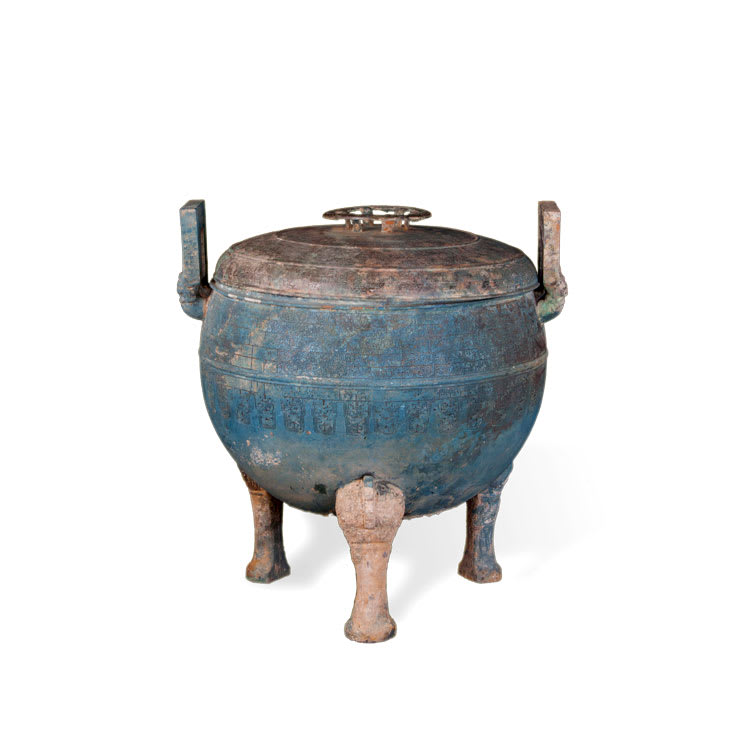Eastern Zhou Bronze Ding with Lid, 770 BCE - 475 BCE
Bronze
44.5 x 48.3 cm
17 1/2 x 19 in
17 1/2 x 19 in
H.1098
Further images
In 1122 B.C., at the battle of Muyeh, the rebellious Zhou tribe defeated the imperial troops of the Shang Dynasty, China’s first Imperial Dynasty. The Zhou Dynasty is itself composed...
In 1122 B.C., at the battle of Muyeh, the rebellious Zhou tribe defeated the imperial troops of the Shang Dynasty, China’s first Imperial Dynasty. The Zhou Dynasty is itself composed of two periods that historians have dubbed Western (1122-771 B.C.) and Eastern (770-221 B.C.). During the Western period, the Zhou ruled from their capital Zongzhou (near modern X’ian). While the Zhou were highly influence by the Shang, over time, they developed their own unique style of decorating bronze and terracotta vessels. Perhaps their most important artistic innovation was the creation of primitive glazes. However, ambitious campaigns to expand their territory westward failed, and in 771, nomadic invaders ransacked Zongzhou, forcing the Zhou to flee eastwards to the city of Chengzhou, which became their second capital.
Thus began the second period, the Eastern Zhou Dynasty, also known as the Spring and Autumn Period, a name taken from one of the oldest histories of China, Lushi Chunqiu, the “Spring and Autumn Annals”. Along the road to Chengzhou, the Zhou relied upon the aid of the powerful Qin and Jin states to secure their escape. Yet, once the Eastern Zhou was established, infighting and succession struggles plagued the house and the Zhou were never able to recapture their ancient dominance, merely ruling in name alone. Instead, a coalition of powerful states, including the Qi and Chu in addition to the Qin and Jin, ruled ancient China. However, by the 5th Century B.C., internal quarrels began to shake the foundations of these independent states and the peace that characterized most of their coexistence began to rapidly disintegrate, culminating in the brutal defeat of the Qi, an event that ushered in the appropriately named Warring States Period.
A ding is essentially a tripod vessel with two raised handles. Originally, the ding was utilized for cooking meats, hung over a fire by its handles. Later, the function of the ding would evolve from the preparation of foods to the presentation and serving of foods at certain rites and festivals. Dings with inscription were primarily used for offering sacrifices to the gods. Their sheer size and stately proportions convey an impression of confidence and majesty, symbolizing both wealth and statehood.
Thus began the second period, the Eastern Zhou Dynasty, also known as the Spring and Autumn Period, a name taken from one of the oldest histories of China, Lushi Chunqiu, the “Spring and Autumn Annals”. Along the road to Chengzhou, the Zhou relied upon the aid of the powerful Qin and Jin states to secure their escape. Yet, once the Eastern Zhou was established, infighting and succession struggles plagued the house and the Zhou were never able to recapture their ancient dominance, merely ruling in name alone. Instead, a coalition of powerful states, including the Qi and Chu in addition to the Qin and Jin, ruled ancient China. However, by the 5th Century B.C., internal quarrels began to shake the foundations of these independent states and the peace that characterized most of their coexistence began to rapidly disintegrate, culminating in the brutal defeat of the Qi, an event that ushered in the appropriately named Warring States Period.
A ding is essentially a tripod vessel with two raised handles. Originally, the ding was utilized for cooking meats, hung over a fire by its handles. Later, the function of the ding would evolve from the preparation of foods to the presentation and serving of foods at certain rites and festivals. Dings with inscription were primarily used for offering sacrifices to the gods. Their sheer size and stately proportions convey an impression of confidence and majesty, symbolizing both wealth and statehood.











